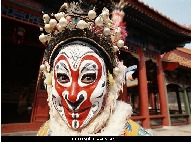 As the most prestigious of all the operas in China, Peking Opera is venerated as the “Opera of China”. The predecessor of it was the huidiao opera of Anhui some 200 years ago. In 1790, an imperial edict was issued to summon the four major huidiao opera troupes-Sanqing, Sixi, Chuntai and Hechun – to go to Beijing to perform and celebrate the 80th birthday of Emperor Qianlong of the Qing. The lyrics of the huidiao opera were so easy to understand that the opera soon captivated the audience of the capital city. In the 50 years that ensured, the huidiao opera in corporated the strengths of the jingqiang opera of Beijing, the kunqiang opera of Jiangsu’s Kunshan which late spread to Beijing, the qingqiang opera of Shaanxi, and other local operas, and gradually evolved into what is today’s Peking Opera. As the most prestigious of all the operas in China, Peking Opera is venerated as the “Opera of China”. The predecessor of it was the huidiao opera of Anhui some 200 years ago. In 1790, an imperial edict was issued to summon the four major huidiao opera troupes-Sanqing, Sixi, Chuntai and Hechun – to go to Beijing to perform and celebrate the 80th birthday of Emperor Qianlong of the Qing. The lyrics of the huidiao opera were so easy to understand that the opera soon captivated the audience of the capital city. In the 50 years that ensured, the huidiao opera in corporated the strengths of the jingqiang opera of Beijing, the kunqiang opera of Jiangsu’s Kunshan which late spread to Beijing, the qingqiang opera of Shaanxi, and other local operas, and gradually evolved into what is today’s Peking Opera.
The stage settings of Peking Opera are succinct and symbolic. Character roles are finely differentiated. Female roles are called dan, male roles are sheng; clowns are chou, and there are also characters using different patterns of makeup which are known as jing. Among the sheng roles are old, young and military charaters. Female roles are defined as qingyi, huadan, laodan, daomadan, wudan. Jing roles feature such patterns of makeup as tongchui, jiazi and wu. Clowns are either scholarly or militant. These four role models form the basis for the emergence of different schools of Peking Opera. Mei Lanfang, Cheng Yanqiu, Xun Huisheng and Shang Xiaoyun were the celebrated “Four Major Dan Roles” in Peking Opera.
|